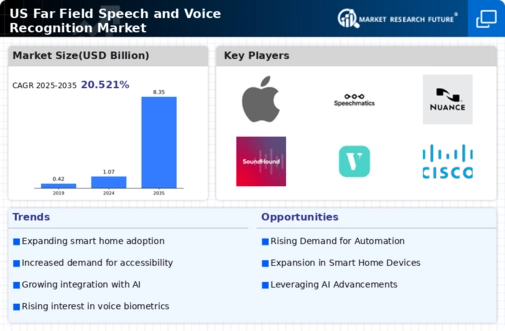Growth of Voice-First Interfaces
The far field-speech-and-voice-recognition market is witnessing a paradigm shift towards voice-first interfaces, which are becoming increasingly prevalent in consumer applications. This shift is largely attributed to the growing preference for natural language processing (NLP) technologies that facilitate seamless interaction between users and devices. Market analysis indicates that the adoption of voice-first interfaces is expected to grow by over 25% annually, as more companies recognize the potential of voice technology to improve customer engagement. This trend is particularly relevant in the retail and service industries, where businesses are leveraging voice recognition to streamline operations and enhance customer service, thereby driving further growth in the far field-speech-and-voice-recognition market.
Expansion of Cloud-Based Voice Services
The far field-speech-and-voice-recognition market is benefiting from the expansion of cloud-based voice services, which offer scalable and flexible solutions for businesses. The shift towards cloud computing has enabled companies to deploy voice recognition technologies without the need for extensive on-premises infrastructure. Recent reports indicate that the cloud voice services market is expected to grow by approximately 30% annually, driven by the demand for cost-effective and efficient solutions. This trend allows businesses to leverage advanced voice recognition capabilities while minimizing operational costs, thereby enhancing their competitiveness in the market. As more organizations adopt cloud-based solutions, the far field-speech-and-voice-recognition market is likely to see accelerated growth.
Rising Demand for Voice-Activated Technologies
The far field-speech-and-voice-recognition market is experiencing a notable surge in demand for voice-activated technologies across various sectors. This trend is driven by the increasing adoption of smart devices, which are becoming integral to daily life. According to recent data, the market for voice-activated devices is projected to reach approximately $30 billion by 2026, reflecting a compound annual growth rate (CAGR) of around 20%. As consumers seek more convenient and hands-free solutions, businesses are compelled to integrate far field-speech-and-voice-recognition capabilities into their products. This demand is particularly pronounced in sectors such as automotive, healthcare, and consumer electronics, where voice interaction enhances user experience and operational efficiency.
Consumer Preference for Personalized Experiences
The far field-speech-and-voice-recognition market is increasingly shaped by consumer preferences for personalized experiences. As users become more accustomed to tailored interactions, businesses are compelled to adopt voice recognition technologies that can deliver customized services. Market Research Future indicates that approximately 70% of consumers express a preference for brands that offer personalized communication through voice interfaces. This trend is particularly evident in sectors such as e-commerce and entertainment, where personalized recommendations can significantly enhance user satisfaction. Consequently, companies are investing in far field-speech-and-voice-recognition solutions to meet these expectations, thereby driving growth in the market.
Increased Investment in Voice Technology Startups
Investment in startups focused on voice technology is significantly influencing the far field-speech-and-voice-recognition market. Venture capital funding for voice technology companies has surged, with estimates suggesting that investments reached nearly $5 billion in 2025 alone. This influx of capital is fostering innovation and accelerating the development of advanced voice recognition solutions. Investors are particularly interested in startups that are developing unique applications for voice technology, such as in healthcare diagnostics and personalized customer service. As these startups bring new products to market, they are likely to enhance the competitive landscape of the far field-speech-and-voice-recognition market, driving further advancements and adoption.





















Leave a Comment